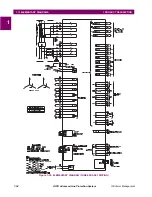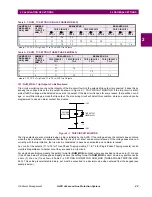
1-40
ALPS Advanced Line Protection System
GE Power Management
1.9 PHASE IDENITIFIED CHANNEL SCHEMES
1 PRODUCT DESCRIPTION
1
1.9.4 FOUR CHANNEL PHASE IDENTIFIED CHANNEL LOGIC
a) PILOT TRIPPING
The local faulted phase determination uses the same algorithms as other ALPS relays. The permissive keying is super-
vised by the fault detecting functions (phase and ground distance, GDOC) and the local fault type determination algorithm.
In addition to providing the permissive signal, the receiver inputs will be compared with the selected local fault type per the
following table to determine which phase(s) to trip.
For the fault conditions shown in Figure 1–22: INTER-CIRCUIT FAULT EXAMPLE, the ALPS on the protected line at the S
substation detects an AG fault and sends channel 1 to the remote terminal. The ALPS at Substation R detects an ABG fault
and sends channel 4 to the relay at S. The ALPS at Substation S issues a single pole phase A trip via the operation of the
Zone 1 ground distance function. The ALPS at Substation R issues a single pole phase A trip per the logic above (Local
fault type is ABG, and only channel 1 is received).
b) ZONE 1 TRIPPING
Faulted phase determination for Zone 1 tripping is the same as in the existing ALPS. This is to allow the Zone 1 elements
to maintain their high speed operation and their independence from the channel.
c) WEAK INFEED TRIPPING
The standard ALPS faulted phase determination algorithm has been supplemented by undervoltage units for Weak Infeed
trips. The phase identified channel logic scheme will use the information in the received signal as well as the undervoltage
units. If there is a local determination of the fault type, the previous table will be used to determine which phases to trip. If
there is no local fault type determination, then the undervoltage functions will be used as in the existing ALPS Hybrid
scheme. If there is no local fault type determination and no undervoltage functions have operated, then the received fault
type will be used to select the trip type.
d) REPEAT (ECHO) KEYING
If no local tripping functions have operated, the repeat keying will be determined by the local fault type determination logic
and the received channels as noted below. If any local trip functions have operated, the channel repeat logic will be blocked
and the local fault type determination will control the keying outputs. If the fault type can not be determined locally, the
received channel(s) will be repeated as received.
Table 1–10: CHANNEL KEYING FOR PILOT TRIPPING (FOUR CHANNELS)
LOCAL FAULT TYPE
XMTR #1
XMTR #2
XMTR #3
XMTR #4
AG
X
BG
X
CG
X
Any interphase faults
X
Table 1–11: PILOT KEYING (4 CHANNEL) LOGIC
LOCAL FAULT TYPE
RECEIVER
PHASES TO
TRIP
1
2
3
4
AG, AB, ABG, CA,CAG,3PH
X
A
BG, AB, ABG, BC,BCG,3PH
X
B
CG, BC, BCG, CA,CAG,3PH
X
C
Any interphase fault
X
A, B, & C
AG
X
A
BG
X
B
CG
X
C
LOCAL FAULT TYPE
RECEIVER
REPEAT KEYING
AG
Any receivers
XMTR #1
BG
Any receivers
XMTR #2
CG
Any receivers
XMTR #3
Any LL or LLG or 3PH
Any receivers
Repeat as received










































